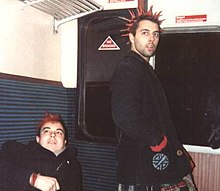
Back موضة البانك Arabic Moda punk Spanish Mode punk French Abbigliamento punk Italian パンク・ファッション Japanese პანკის მოდა Georgian 펑크 패션 Korean पंक फेसन NEW Punk (mode) Dutch Moda punk Portuguese


Punk fashion is the clothing, hairstyles, cosmetics, jewellery, and body modifications of the punk counterculture. Punk fashion varies widely, ranging from Vivienne Westwood designs to styles modeled on bands like The Exploited to the dressed-down look of North American hardcore. The distinct social dress of other subcultures and art movements, including glam rock, skinheads, greasers, and mods have influenced punk fashion. Punk fashion has likewise influenced the styles of these groups, as well as those of popular culture. Many punks use clothing as a way of making a statement.[1]
The early, pre-fame work of designer Vivienne Westwood helped pioneer the look of early British punk with her scene-establishing clothing shops Sex and Seditionaries in the mid-1970s, co-run with Malcolm McLaren who managed the Sex Pistols. Westwood was asked by then-partner McLaren to outfit the Sex Pistols, and Westwood's designs found a canvas on Johnny Rotten and Sid Vicious.[2] Her early work with Sex and the Sex Pistols helped to establish her as one of the most influential British designers of the 20th century.[3]
Punk fashion has long been commercialized,[4] with well-established fashion designers like Zandra Rhodes,[5][6][7] Thierry Mugler,[8][9] Jean Paul Gaultier,[10][11] Stephen Sprouse,[12][13] and Anna Sui[14][15] using punk elements in their production and the first punk-influenced fashion spreads appearing in mainstream fashion magazines as early as 1976.[16]
- ^ Hudson, Alice (2016). "Understanding the Politics of Punk Clothing from 1976 to 1980 Using Surviving Objects and Oral Testimony" (PDF). University of Brighton (Dissertation). Archived from the original (PDF) on 2018-04-03. Retrieved 2019-02-12.
- ^ Andrew, Scottie. "How Vivienne Westwood dressed the Sex Pistols and shaped punk". CNN. Retrieved 2023-04-01.
- ^ Price, Authors: Shannon. "Vivienne Westwood (born 1941) and the Postmodern Legacy of Punk Style | Essay | The Metropolitan Museum of Art | Heilbrunn Timeline of Art History". The Met’s Heilbrunn Timeline of Art History. Retrieved 2023-04-01.
- ^ Hyde, Nina S. (1978-01-01). "Fashion Notes". The Washington Post. Retrieved 2022-04-04.
...[P]unk...has inspired the huge trash cans with shoulder ropes being sold...as trendy carryalls at New York's Fiorucci.
- ^ Mulvagh, Jane (1988). "1977". Vogue History of 20th Century Fashion. London, England: Viking, the Penguin Group. p. 356. ISBN 0-670-80172-0.
1977: Rhodes presented a 'punk' collection of ripped, zipped and safety-pinned jersey evening dress...
- ^ Hyde, Nina S. (1977-10-29). "And Now 'Punk Chic'". The Washington Post.
The French are not the first to exploit punk fashion. British fashion designer Zandra Rhodes incorporated rips and tears and safety pins into $600 silk crepe dresses a season back [spring 1977]. Stores like Sakowitz in Houston sold them 'rather well,' according to Robert Sakowitz, the store owner.
- ^ Morris, Bernadine (1977-09-17). "All Around Town, a Week of Lavish Couture Openings". The New York Times: 19. Retrieved 2022-04-04.
...Zandra Rhodes, the British designer who transcribed the punk rock image into the idiom of high fashion....Zandra Rhodes...catapulted 'punk rock' to the fashion world's attention....The style is characterized by cutouts, safety pins and chains...In Miss Rhode's versions, there was not much of the aggressive, sadistic punk rock flavor.
- ^ Hyde, Nina S. (1977-10-24). "Thinking Big for Spring". The Washington Post. Retrieved 2022-02-07.
There is punk influence at Thierry Mugler, including a punk model with fluorescent yellow hair...
- ^ Hyde, Nina S. (1977-10-29). "And Now 'Punk Chic'". The Washington Post. Retrieved 2022-04-04.
At Thierry Mugler, black leather and safety-pin jewelry showed up on the runway worn by the cool, blonde [French punk icon] Edwige.
- ^ Mulvagh, Jane (1988). "1976-1986". Vogue History of 20th Century Fashion. London, England: Viking, the Penguin Group. p. 345. ISBN 0-670-80172-0.
...Jean-Paul Gaultier fused the showmanship of a couture training...with the design anarchy borrowed from London's streets...
- ^ Cunningham, Bill (1986-03-01). "Bright Spring Fashion Takes a Brave New Direction". Details. IV (8). New York, NY: 98. ISSN 0740-4921.
Jean Paul Gaultier...defines the neo-punk yuppies.
- ^ Cunningham, Bill (1988-03-01). "Fashionating Rhythm". Details. VI (8). New York, NY: Details Publishing Corp.: 119. ISSN 0740-4921.
Stephen Sprouse...continues to manipulate...the Sixties hippie and Seventies punk influences...
- ^ Goodman, Wendy (1987-09-21). "Stephen Sprouse Tries a Comeback with a Solid New Store". New York. 20 (37): 139. Retrieved 2022-08-18.
Stephen Sprouse...T-shirts printed with safety pins, skulls, and barbed wire; eleven-inch micro-skirts in...camouflage patterns;...dresses covered with gold safety pins...
- ^ Nika, Colleen (September 14, 2011). "Exclusive: Anna Sui Discusses Her Spring 2012 Show and Punk Rock Heritage". rollingstone.com. Rolling Stone. Retrieved November 2, 2016.
- ^ Drain, Kelsey (May 13, 2016). "Opening Ceremony, Anna Sui Capsule Collection Launches; Designer's '90s Pieces Reissued". fashiontimes.com. Fashion Times. Archived from the original on November 4, 2016. Retrieved November 2, 2016.
- ^ Mulvagh, Jane (1988). "1976". Vogue History of 20th Century Fashion. London, England: Viking, the Penguin Group. p. 353. ISBN 0-670-80172-0.
1976: The punk image began to be covered in Italian Vogue, which featured page after page of black clothing worn with aggressive accessories: low-slung, studded belts, leather knuckle-dusters, dog chains, and wrap-around sunglasses. Hair was dishevelled and tied with black lace ribbons.